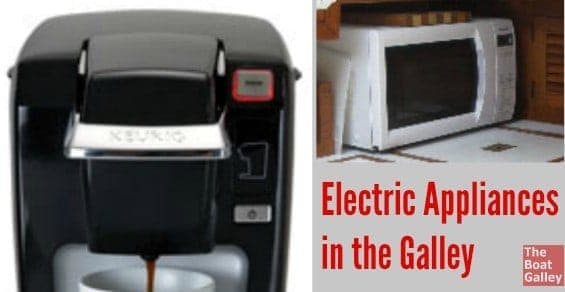Should you or shouldn’t you have any electric appliances in the galley? Almost every time that I write a post about using an electric appliance, I get some comments about “I never have anything that requires electricity.” And then when I write about a manual option, I get other comments suggesting an electric option.
The truth is that different options work on different boats and for different lifestyles. And, to be honest, my own thoughts on using electricity have changed over time as charging options have changed.
If you’re primarily a liveaboard at a marina or dock where you are hooked up to shore power, you can use pretty much anything you want, even air conditioning. But if you spend considerable time at anchor or on a mooring, you need to consider your boat’s electrical setup.
If your boat is set up with a large battery bank, good charging capability and a suitable inverter, why use not use electric appliances if you want to? Of course, you should always have a manual backup just in case!
On Que Tal, we had a 450 amp-hour house battery bank, 450 watts of solar power for charging (in a very sunny climate with almost no clouds), a 100 amp alternator and a 2500 watt inverter/charger. While we couldn’t go wild with electric appliances, we did have a microwave that Dave used frequently to make a bag of popcorn and I used an electric coffee grinder every day.
The Geminis that we are looking at (update: now have) have a very different electrical set up, starting with a propane refrigerator instead of a 12 volt one. That means that there is a far smaller battery bank — typically about 150 amp-hours — and less charging and only a 1000 watt inverter. Even if we had a larger inverter, the battery bank and charging system won’t support any large electrical loads without substantial upgrades. So while we might still have an electric coffee grinder, the microwave is out of the question. Most coffee makers take a larger inverter, too. An immersion blender — probably okay.
You need to consider three factors if you’re going to run an appliance from an inverter:
- Inverter: will your inverter supply the power needed? Most appliances need a little extra power right when they start up, called the “start up load” (imaginative, huh?) or sometimes the “peak load” or “surge load.” The inverter has to be sized for this or its internal circuit breaker will trip. Few appliances state their start up load, but a general rule of thumb is double the operating load — which is usually stated. Items with a compressor or pump often take even more on start up — as much as 3 to 7 times the running load.
- Batteries: can your batteries supply the power needed? Even if your inverter can handle the load, the batteries may not be able to discharge the amps as fast as the inverter is calling for them. You may be able to find the maximum discharge current in the specs for your batteries (some manufacturers provide this; others don’t).
- Charging: will you be able to replace the power that you use before you need it for something else? Further, insufficient charging will damage your batteries and considerably shorten their life.
Okay, and maybe a fourth item — is there an outlet near where you want to use the appliance? Whether you have a whole boat inverter or just have to use the plug on the inverter, this can be an important consideration.
Further, for any appliance that has sophisticated electronics in it or a variable speed motor, you need a pure sine wave inverter or you can ruin the appliance. Read more about inverters.
As battery and charging technology is improving, solar panels are becoming more efficient and also costing less, and larger pure sine wave inverters are coming down in price (not to say they’re cheap now, but a lot less expensive than 10 years ago), it’s becoming more and more common for boats to have the capability to run electrical appliances that were once considered impossibilities.
Another option is to have a generator and run electrical appliances directly from it. But before jumping on this bandwagon, think about whether you really want to fire up the generator every morning to make a cup of coffee (the quiet of the morning is one of the thing we treasure most about being at anchor) or to make a bag of popcorn. And if you do plan to use a generator to supply the power, make sure it’s large enough for the start up load.
Bottom line: you’re not totally crazy to want or have electrical appliances on board, but you need to think out the entire power system. Most boats opt for a few things that are important to them, but don’t have all the electrical gadgets that they might have ashore.
The good news: there are manual ways to do just about anything that you can do with electricity. And most of them work pretty well; some will even provide some fitness benefits as a side benefit 🙂

Carolyn Shearlock has lived aboard full-time for 17 years, splitting her time between a Tayana 37 monohull and a Gemini 105 catamaran. She’s cruised over 14,000 miles, from Pacific Mexico and Central America to Florida and the Bahamas, gaining firsthand experience with the joys and challenges of life on the water.
Through The Boat Galley, Carolyn has helped thousands of people explore, prepare for, and enjoy life afloat. She shares her expertise as an instructor at Cruisers University, in leading boating publications, and through her bestselling book, The Boat Galley Cookbook. She is passionate about helping others embark on their liveaboard journey—making life on the water simpler, safer, and more enjoyable.
Simplify meal prep on board with proven strategies for provisioning, maximizing fridge space, and cooking delicious meals aboard your boat.










tami says
of course, now that you’re contemplating a catamaran, one of your biggest considerations will be weight. That is to say, if you’re interested in keeping her performance somewhat lively. More gadgets, more things to run the gadgets, more weight.
and of course, the complexity involved 🙂
Chris says
Three more things. If you are using electric (120-240 AC) aboard, each branch circuit should be wired with a Ground Fault Interrupter (GFI) outlet. The opportunity to electrocute one’s self is significantly greater aboard a boat. GFI’s tripping can be a nuisance, but you live to complain about them. Second. Outlets mounted in galleys and heads, or anywhere water can spray/splash, should have spring loaded, gasket snap covers. Third, outlet boxes should have an environmental enclosure on the back side. to prevent anyone/anything inadvertently shorting the contacts. These requirements are similar to what one would face if wiring a pool house or outdoor kitchen.
Capt Jerry Robbins,usmm(ret) says
Thanks Chris for the great but simple advice! I am amazed at the crazy things that (Normal) people do to kill themselves on a boat things they would not even consider while at home or work!
Carolyn Shearlock says
All great points, Chris! Thanks for adding.
Chris says
I need to emphasize, household GFIs are not ignition protected and should not be used on gas powered vessels. My comment about outdoor kitchens and pool houses may have mislead.
Darlene Burnett Price says
No appliances!
Eric says
Best, and only, electric appliance is an inexpensive ice maker. Runs on 25 watts, cost just over $100 on Amazon. I turn it on at 4 and have plenty of ice by happy hour. Any ice left over goes in a bag in the freezer.
Eric says
Correction. 240 watts, not 25. But my 1000 watt inverter handles it fine.
Claudita Carito says
Thanks, we have some but not to many!
Ron Newton says
I have a 3870 Bayliner cruiser with a 8.0 diesel gen. I use the electric range and toaster oven everyday, I have a electric grill, coffee maker, microwave and crockpot that get used on occasion. The micro is used for storage more than cooking but is handy for warming leftovers or popcorn.
Melinda Taylor says
What, give up my blender? No more frozen mango margaritas? Never.
B.Goodrum says
XD LOL I Second that Melinda 😉
D and Don svsoutherncross says
For us a small grinder for coffee beans and a very small microwave (800 watts) work for us with a 500 amp hour battery bank (the battery bank is 2 -8D Concord Lifeline AGM batteries) , 2 – 130 watt Kyocera solar panels, a Air X wind generator at the top of the mizzen mast, a 1500 watt inverter/charger and 100 amp alternator (normal output about 75 watts). We call the microwave the solar cooker, as the solar panels seem to take care of it in most instances. For those gray and windless times we have a Honda 2000 generator. This set up has worked well for us so far.
Helen Bell says
Tiaster, microwave, electric skillet, coffeemaker, magic bullet, bread machine, hmmm i think thats it lol
Helen Bell says
P.s. Huge battery bank, no generator and we live mostly at anchor
Ann Capehart says
microwave, coffee pot
Rita M. Riley says
All those in the picture! Keurig, toaster, and built-in microwave. Docked at marina; shore power.
David Wright says
NONE. Thats kinda the point for us
Desserine Williams says
With shore power, Nuwave oven and cook top, coffee maker, tiny fridge, blender.
Lynn Kaak says
We live on the hook. No electric appliances, unless you count the fridge. Although a hand blender might be nice to have once in a while. But we also don’t need a generator (complete with the noise, maintenance and diesel expenses) and happily do well with our solar panels. We have a stove top toaster and waffle iron, and a hand coffee grinder, and insulated French press coffee maker.
Pamela Dakin Harwood says
Can you post a pic of your waffle iron. Sunday mornings just wouldn”t be the same without waffles . . . .
Richard Kokemoor says
I have one of these I got for 50 cents at a thrift sale – works great!
http://amzn.to/2DNdNCF
Tim Sheahan says
None, been on the hook for a year n lovn it.
Barb says
When we moved aboard La Luna had a toaster oven and a second fridge — a small electric one. Both are gone. We use an old fashioned coffee percolator, the second fridge itself is still on board with the guts gone. EW uses it for dry storage of filters and other parts. I have a hand mixer, and a vacuum bagger that I have to run the generator to use, and a stick blender that works on the inverter, Don’t miss a thing.
Dave Tew says
We have a jump start battery pack and small inverter to power our few electrical appliances.
Bonnie Gibson-Cunningham says
Espresso machine :-0
Lupari Sue says
Stick blender, and hand beater. Love em both and they take next to no power. Have a microwave but use it as a bread cupboard coz we dont have enuf power for that.
Gale Golden Schulke says
The only electric appliances I have are my Kitchenaid mixer and the handheld mixer. Everything else is manual.
Gale Golden Schulke says
Lynn: stove top toaster. WHERE did you get it and what does it look like. I so want one.
Peter Robertson says
1. 10 cup coffee maker with a stainless insulated carafe. It uses power to perk, about 1200 watts for 6 minutes, then turns off. 2. Oster blender for the occasional Margarita. 3. Microwave oven that spends 99.999% of it’s life as the perfect breadbox! (We honestly can’t remember the last time it was fired up)
Kimber Jo Strasser says
Docked at a marina with shore power so I love my electric appliances.
Tammy Swart says
Toaster
Nikki says
coffee maker, toaster, stick blender, food chopper, hand electric whisk, fridge, freezer, microwave, three tier steamer, fans…… All essential of course!!
Deb Akey says
Magic Bullet
Jennifer Dean Neumann says
Everything! No propane 🙁 it’s a powerboat. We have an electric cooktop, convection microwave and a dishwasher. Have to run the genny to cook. We have a toaster and a Keurig also.
Ted Reshetiloff says
Vitamix, coffee grinder, coffee maker. 400 watts solar and 1200ah battery bank. 3kw inverter is our friend!
Nancy Orloski says
Washer and a Dryer! Along with so many. I feel guilty somewhat by ready others!
Gary Thornburgh says
Just added this in the shower of our boat to save counter space.
Ann Chase says
Crockpot, coffeemaker and Nutribullet.
Skylar Walker says
Toaster, stick blender
Jan Drury says
I’m not going to feel guilty about my appliances. After all, we no longer live in the dark ages now do we. If my Thermomix makes life easier, thats a good thing, isnt it? To the diehards with nothing onboard: good onya, but to each their own. Having appliances doesnt make one less or more of a sailor, its all about having more time to enjoy the fabulous places we anchor in.
Eva Oldfield says
Thermomix and kettle but only when on shore power. Does the 12v vacuum cleaner count as a galley item?
Paul Daniela Herlihy says
Actually, we are removing our microwave to gain more storage. Microwave is nothing more than a popcorn popper…
Sherry Matas says
Popcorn is much easier stove top than microwave with out all of the harmful chemicals (popcorn lung).
We have lots of small kitchen gadgets on board, but are very selective on when they are used… electric fondue pot, ice cream maker, Waring commercial stainless steel blender, bullet blender, microwave. Other than they microwave, they all run off the house bank. We also have alternatives for shortening the small appliance run time.
Laine Common says
Oh man.. I don’t think I could live without my gadgets… Kitchen aid mixer, vitamix blender, food processor, immersion blender, crockpot, induction stovetop, toaster, oven/range, apartment size fridge/freezer.. We have a microwave but I stay away from it. In fact, I think hubs disconnected it to work on some wiring and never hooked it back up lol.
Todd Hoevel says
Stephen Strasshofer
Donna Lynn Tourt Cantwell says
Rich Cantwell
Amy Domaratzki says
We had big plans to go without but we now have an electric kettle, a small Toaster, and an induction cooktop for when we have power or are underway with engines.
Darlene Luxton says
We have a diesel hob!! Which also a fan heater!!
Susan Spiller says
Jim, things to think about when we buy our next boat.
Jim Spiller says
I was just going to tag you LOL 😊❤️
Darlene Luxton says
We have microwave, kettle and an electric all in one cooker! Why do without if you don’t need to!
Ron Newton says
I have a 3 burner electric stove with oven, microwave, A/C-D/C refrigerator, coffee maker and electric grill. Air conditioning-2 units, electric built in heaters-3, tv and lamps. Also a Westerbeke 8 kw diesel generator for power while on the hook.
John Keller says
They are wonderful. We have a Nespresso for great coffeee. A Vitamix for smoothies and shakes. Microwave and a full size refrigerator. Oh and a tv and a Mac Mini with over 300 movies to watch! Just make sure your inverter is a pure sine wave. Most coffee makers will not like square wave ac.
The Boat Galley says
Yes, I’ve written about the differences in inverters. The Vitamix also requires pure sine wave.
Dave Skolnick (S/V Auspicious) says
Well written article Carolyn. I’d like to add two points.
First, since Carolyn mentioned small inverters powered locally be aware that the cigarette lighter power points most of us use are limited to a continuous power draw of only 6A. That means a limit of just over 70W for any appliance that runs for more than about a minute. Stick blenders are okay, coffee makers are not.
Second, systems that depend on 117VAC or 220VAC appliances are more fragile than propane and 12VDC. I speak from my perspective as a degreed naval architect and marine engineer and as an active delivery skipper. I move a LOT of boats and have a very broad base of experience. I shudder when I walk on a boat with electric cooking. There have been too many times when a generate failure or a string of cloudy days means no cooking. No coffee. Puts refrigeration at risk. It makes less difference when everything works right but rarely does everything work right. The greater the number of single points of failure the more likely you will be without a capability.
If you are always in marinas and can plug in it makes little difference. If you cruise, anchor out, or make passages then electric galleys are a poor choice. You should look at every electric appliance and think through what you will do without it. The time will come when you will have to do without it.
Pete says
We have toaster. Mixer. Etc. our coffee grinder is a Krupa. 👍👍👍👍👍Superb little unit. Beats even our monster cafe size Mazza at home. Also have a spndrier for rinsing the washing. 1800 rpm. Amazing. We cruise offshore and this makes drying so quick.
Rick Nicholson says
First I am not a full time cruiser, but do plan one month cruises through the Inside Passage up to Alaska area, boat moored in Comox, a hop, skip and jump to these areas. And I, love to cruise off season [Translation: lots of cloudy days with no sun]. And I’m also a fan of redundancy, lots of redundancy. My boat is an express cruiser power boat 29 feet in lenght with 70 amp alternator Merc V8 (I have just re-powered). I have a Force 10 two burner stove/oven, a Weber Q1200 BBQ and a convection oven (1380 watts).
I use an Efoy 210 to charge batteries when on the hook, I prefer this system over solar because again I am in an area that can go a week without sun – easily. The batteries are Firefly’s, six of them for a total of close to 700 amps, 560 usable amps. Most of the time I use propane but I can also roast a small whole chicken on the convection taking 50 minutes and roughly 100 AMP’s of power. Propane is used for my Dickensen heater as well as the stove/oven and BBQ. But I also had a diesel heater installed, even though I run a gas engine with a small fuel tank of a couple of gallons. Your problem where you are is too much hot humid weather, my problem is too much cold humid weather. Should I be low on propane, or want to extend it, I can use the convection oven.
I gave microwave ovens a very long deep thought.. My re-fitter said he’d put one in if I wanted it but assured me that I just wouldn’t use it that much, he didn’t have one and didn’t miss it. So I watched how I and my wife use our home microwave and realized that indeed other alternatives could be used to do what it did. So for your husband, he could just find a small electric corn popper with as low wattage as is available, or he can make it the way we and probably you did when you were a kid and heat oil in a larger pot and make it over the stove.
Kathleen Mooney says
I ued to love baking while sailing. Especially muffins and cookies. Our little boat has an OMNI (?) alcohol/electric stove which I’m learning to use, but I think a small toaster oven would be really nice. We are on a power boat now (sory to admit it) and seem to have good strong batteries/inverter, so a mini toaster oven/convection oven might be perfect.
Any suggestions? What brand? Does adjustable temperature help keep the power draw down.?
Also, Where can I find the best alcohol for our stove. It seems tricky to find in our British Columbia coastal towns. There seem to be many different types of alchol too.
Kathy